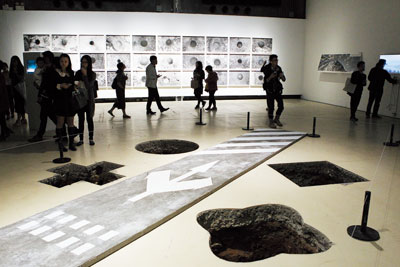 Cao Zhen caozhen0806@126.com FROM Europeans’ landfall in the New World across the pond in the 16th century to Americans’ Westward Movement in the 19th century, from Neil Armstrong’s first Moonwalk in the 1960s to the Mars Exploration of recent years, humans never stop exploring new lands. Likewise, ambitious artists also explore the inextricable connections between humans and land or between art and land by adventuring to deserts, mountains or terrains afar. These artists, particularly in the United States in the 1960s, rejected museums and galleries as the setting of artistic activity by using natural materials such as soil, rock and water to form the renowned Land Art Movement in Western art history. Half a century later, “Digging a Hole in China,” an exhibition featuring Chinese earthworks created within the land, is being held in Shenzhen, where housing prices have been skyrocketing in recent years. Curator Venus Lau said the exhibition is not the Chinese version of the Land Art Movement because the Western movement in the 1960s was a response by a generation of young artists to the political activism and the emerging environmental and social liberation movements at that time, while the Chinese earthworks that emerged in the late 1980s were created in the unique Chinese urbanization context. “In the late 1960s, changes in the cultural and social climate around the globe led a group of Western artists to desolate places — the so-called ‘nowhere.’ These artists demarcated themselves apart from established systems of consumer society, capital and rigid art institutions through their geographical retreat. There’s a coincidence that at that time in China, thousands of young urban intellectuals and artists were sent to rural regions by the government as part of the ‘Down to the Countryside’ movement to help develop rural areas,” said Lau. Lau said the concept of land art was introduced to China in the mid-1980s. While at that time consumerist society was still nascent in China, Chinese land art didn’t necessarily take consumerism as its theme. “In the past three decades in China, society has gone through groundbreaking transformations and the land has changed drastically, so exploration in the connections among land, rules, ownership, policies, history and laws have been represented in diverse forms in China’s contemporary art,” said Lau. Lau explained that the exhibition title “Digging a Hole in China” was borrowed from the old English idiom “dig a hole to China.” And at the exhibition hall in OCT Art Terminal, two rows of oddly shaped holes can be found on the ground. These holes are part of the artwork “Propitiation” created by Liu Wei and Chen Haoyu in 2007. Between the rows are printed a few road signs, such as zebra crossing and direction arrows. Lau said the holes’ shapes are Taoist symbols that have no specific significance in this project. “Propitiation” uses symbolic techniques to explore the relationship between social order, the order of people’s existence, and the roads, buildings, and vertiginous pace of change in a large metropolis. Another distinction between Western land art works and Chinese earthworks lies in that the former were mostly created in deserts, valleys and terrains with natural materials such as soil, rock, logs and leaves, while some of the latter used introduced materials such as concrete and asphalt and made artworks in cities. In Zhang Liaoyuan’s video “1 Square Meter,” he documents the process of obtaining a government permission to allow him to cut out a piece of cement 1-square-meter in size in downtown Hangzhou. “After I got the permission, I dug up the road but quickly repaired it,” said Zhang. “I did this project to explore the administrative approval process for land in a metropolis. My application was simple and I told the government that I was doing an artistic project.” Liu Chuang’s video “Untitled (Dancing Partner)” and Cao Fei’s video “East Wind” are two other works that document their experiments in cities. In “Untitled (Dancing Partner),” two identical cars drive side by side on in the heavy traffic of downtown Beijing at the lowest legal speed limit. In the video, visitors can see other cars overtake the two identical “annoying” cars. Liu said the two cars in the experiment were strictly abiding by the road rules but it seems that the two cars caused “trouble” for other cars. He believes that the collective ethics of road users are essentially a coercive binding by the majority on the minority. “East Wind” is anther bizarre experiment in which a rural truck’s headstock is decorated as the blue Thomas the Tank Engine and was driven around Beijing. The “Thomas” truck attracted curious passers-by and was even stopped by a traffic officer. The work also reflects and defies road rules and regulations. There are also works exploring changes in agriculture and urban waterways. Xu Qu’s video “Upstream” records his aimless rowing with a friend down a river from the northern outskirts of Beijing and eventually arriving in front of Zhongnanhai. He said the random voyage told him that in a city, waterways used to be connected together with rivers but on the surface they are divided by roads and buildings. The only artwork made in a desert at this exhibition is Zhuang Hui’s “11-degree Incline,” in which the artist placed a stunning black-lacquered metal replica of the Dashuifa (The Great Fountain Main Facade) ruins from the burned Old Summer Palace in a desert at the junction between Qinghai and Xinjiang. He also placed leftovers from construction sites and woodwork in the desert, presenting his thoughts on past and present, time and space, and ruins. He said he removed the historical surface of the ruins and placed them in the desert to let them decay perpetually in the sands. Dates: Until June 26 Hours: 10 a.m.-5:30 p.m. Closed Mondays Venue: Exhibition Hall A, OCT Art Terminal, South Area, OCT-LOFT, Nanshan District (南山区华侨城创意文化园南区OCT当代艺术中心A展厅) Metro: Luobao Line, Qiaocheng East Station (侨城东站), Exit A | 
